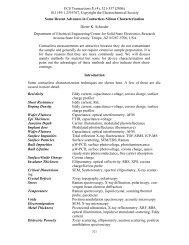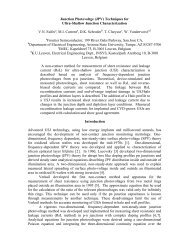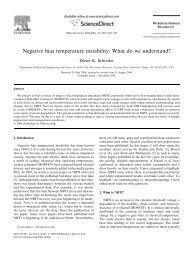The Role of the Mercury-Si Schottky-Barrier Height in ... - IEEE Xplore
The Role of the Mercury-Si Schottky-Barrier Height in ... - IEEE Xplore
The Role of the Mercury-Si Schottky-Barrier Height in ... - IEEE Xplore
You also want an ePaper? Increase the reach of your titles
YUMPU automatically turns print PDFs into web optimized ePapers that Google loves.
CHOI et al.: ROLE OF THE MERCURY-SI SCHOTTKY-BARRIER HEIGHT IN -MOSFET 1381<br />
Fig. 1.<br />
Band diagram for (a) no <strong>in</strong>terface states, (b) a surface state captur<strong>in</strong>g<br />
an electron, and (c) a high density <strong>of</strong> surface states at E 0 0:7 eV.<br />
0.7 eV, presumably because <strong>the</strong> hydrogen-term<strong>in</strong>ated <strong>Si</strong> surface<br />
is no longer passivated, and surface states form, lead<strong>in</strong>g<br />
to Fermi-level p<strong>in</strong>n<strong>in</strong>g. should decrease to 0.42 eV when<br />
<strong>in</strong>creases to 0.7 eV.<br />
A similar barrier height change has been reported for Al–n-<strong>Si</strong><br />
<strong>Schottky</strong> barriers, where <strong>the</strong> barrier height changed from 0.45 to<br />
0.7 eV after Al evaporation and ag<strong>in</strong>g at room temperature for<br />
about 100 h [10]. <strong>The</strong> proposed mechanism is a positive oxide<br />
charge <strong>in</strong> <strong>the</strong> th<strong>in</strong> oxide film ( 2 nm) between <strong>the</strong> Al and <strong>the</strong><br />
<strong>Si</strong> that exists at <strong>the</strong> time <strong>of</strong> Al evaporation. This positive charge<br />
provides a dipole contribution, reduc<strong>in</strong>g <strong>the</strong> ideal barrier height.<br />
Thicker oxides lead to lower barrier heights. With ag<strong>in</strong>g, this<br />
positive charge dissipates and <strong>the</strong> true barrier height <strong>of</strong> 0.7 eV<br />
obta<strong>in</strong>s. <strong>The</strong> charge dissipation mechanism was speculated to be<br />
due to electron <strong>in</strong>jection from <strong>the</strong> <strong>Si</strong> substrate. For our Hg–n-<strong>Si</strong><br />
case, we assume <strong>the</strong>re is no oxide immediately after HF etch<br />
and as <strong>the</strong> oxide forms, <strong>the</strong> barrier height reduces. Hence, we<br />
believe <strong>the</strong> mechanisms <strong>in</strong> <strong>the</strong>se two cases to be different.<br />
Why does change? We propose a possible explanation.<br />
Fig. 1(a) shows <strong>the</strong> band diagram immediately after HF or NH F<br />
etch with its 0.45 eV barrier height. We believe <strong>the</strong> <strong>Si</strong> surface<br />
to be hydrogen term<strong>in</strong>ated with most <strong>of</strong> its surface states passivated<br />
by hydrogen. After expos<strong>in</strong>g <strong>the</strong> H-term<strong>in</strong>ated sample<br />
to air, <strong>the</strong> barrier height changes and <strong>the</strong> Hg–<strong>Si</strong> contact angle<br />
<strong>in</strong>creases from 121 to 151 [9]. Clearly, <strong>the</strong> Hg–<strong>Si</strong> <strong>in</strong>terface<br />
changes physically and electrically. Dur<strong>in</strong>g room-temperature<br />
oxidation, <strong>Si</strong>–<strong>Si</strong> and <strong>Si</strong>–H bonds at <strong>the</strong> surface are converted to<br />
<strong>Si</strong>–O bonds. However, similar to <strong>the</strong>rmal oxidation at elevated<br />
temperatures, some <strong>Si</strong> bonds rema<strong>in</strong> “unbonded,” becom<strong>in</strong>g <strong>in</strong>terface<br />
states. We believe <strong>the</strong>se to be surface generation sites or<br />
surface states. <strong>The</strong>se surface states are likely to be <strong>the</strong> cause <strong>of</strong><br />
<strong>Schottky</strong>-barrier height changes. Let us consider <strong>the</strong> formation<br />
<strong>of</strong> surface states <strong>in</strong> Fig. 1(b). If <strong>the</strong>se states are acceptor-like,<br />
<strong>the</strong>y capture electrons from <strong>the</strong> <strong>Si</strong> substrate, lead<strong>in</strong>g to <strong>in</strong>creased<br />
barrier height. With time, <strong>the</strong> surface state density <strong>in</strong>creases and<br />
f<strong>in</strong>ally saturates lead<strong>in</strong>g to Fermi-level p<strong>in</strong>n<strong>in</strong>g [11], from <strong>the</strong><br />
<strong>in</strong>itial 0.45-eV barrier height to 0.7 eV, <strong>in</strong>dicated <strong>in</strong> Fig. 1(c).<br />
Are surface states generated dur<strong>in</strong>g room temperature oxidation?<br />
In an earlier paper, we showed that <strong>the</strong> effective SOI film<br />
generation lifetime , determ<strong>in</strong>ed with <strong>the</strong> pulsed po<strong>in</strong>tcontact<br />
-MOSFET, varies with time follow<strong>in</strong>g HF passivation<br />
[12]. In this technique, <strong>the</strong> substrate potential is pulsed, driv<strong>in</strong>g<br />
<strong>the</strong> <strong>Si</strong> film <strong>in</strong>to deep depletion. <strong>The</strong> result<strong>in</strong>g electron-hole pair<br />
generation leads to a time-dependent dra<strong>in</strong> current, from which<br />
<strong>the</strong> effective generation lifetime is determ<strong>in</strong>ed [13]. <strong>The</strong> electron-hole<br />
pair generation takes place with<strong>in</strong> <strong>the</strong> <strong>Si</strong> film, at <strong>the</strong><br />
<strong>Si</strong>/buried oxide <strong>in</strong>terface, and at <strong>the</strong> <strong>Si</strong> surface. After HF passivation,<br />
surface generation is low because <strong>the</strong>re are few surface<br />
Fig. 2.<br />
etch.<br />
Forward <strong>Schottky</strong> diode current as a function <strong>of</strong> time after dilute HF<br />
states. As <strong>the</strong> passivation loses its effectiveness, surface generation<br />
becomes active and decreases from 4 s and saturates<br />
at 0.17 s after about 100 h. <strong>The</strong> behavior is repeatable<br />
when <strong>the</strong> wafer is aga<strong>in</strong> r<strong>in</strong>sed <strong>in</strong> dilute HF. We found analogous<br />
behavior for SIMOX and bonded wafers and for dilute HF<br />
and dilute iod<strong>in</strong>e surface r<strong>in</strong>ses. We believe <strong>the</strong> effective generation<br />
lifetime behavior is caused primarily by <strong>the</strong> <strong>Si</strong> surface<br />
between source and dra<strong>in</strong> po<strong>in</strong>t contacts, not by <strong>the</strong> contacts<br />
<strong>the</strong>mselves. This surface changes with time, generat<strong>in</strong>g surface<br />
states, which, <strong>in</strong> turn, <strong>in</strong>crease <strong>the</strong> surface electron-hole pair<br />
generation rate. It is very likely that similar surface changes affect<br />
<strong>the</strong> Hg–<strong>Si</strong> <strong>in</strong>terface.<br />
Fig. 2 shows <strong>the</strong> forward-bias current <strong>of</strong> an Hg–<strong>Si</strong> <strong>Schottky</strong><br />
diode on an n-<strong>Si</strong> substrate. <strong>The</strong> current is <strong>in</strong>itially very low,<br />
jumps to 0.9 mA after dilute HF etch and <strong>the</strong>n gradually decl<strong>in</strong>es.<br />
This behavior is similar to <strong>the</strong> pulsed -MOSFETs measurements<br />
for an entirely different structure. Instead <strong>of</strong> surface<br />
generation rate affected by <strong>the</strong> HF etch, <strong>in</strong> Fig. 2 it is <strong>the</strong> barrier<br />
height that is changed. For <strong>the</strong> measurements <strong>in</strong> Fig. 2, Hg<br />
contact was made for <strong>the</strong> measurements. <strong>The</strong> probe was lifted<br />
between measurements. Hence, <strong>the</strong> <strong>Si</strong> surface was exposed to<br />
air most <strong>of</strong> <strong>the</strong> time, except for <strong>the</strong> measurement times when<br />
<strong>the</strong> Hg probe contacted <strong>the</strong> surface.<br />
III.<br />
HgFET<br />
<strong>The</strong> HgFET is a version <strong>of</strong> <strong>the</strong> <strong>Schottky</strong> MOSFET <strong>in</strong> Fig. 3,<br />
consist<strong>in</strong>g <strong>of</strong> a bulk p-type substrate with <strong>Schottky</strong> source and<br />
dra<strong>in</strong> contacts, first proposed by Lepselter and Sze and later<br />
modified and demonstrated by o<strong>the</strong>rs [14]–[19]. <strong>The</strong> band diagrams<br />
near <strong>the</strong> surface are shown <strong>in</strong> Figs. 3 for zero, negative,<br />
and positive gate voltages. For dra<strong>in</strong> current to flow with negative<br />
gate voltage, <strong>the</strong> hole barrier height should be low,<br />
whereas for positive gate voltage <strong>the</strong> electron barrier height<br />
should be low, illustrat<strong>in</strong>g <strong>the</strong> conflict<strong>in</strong>g barrier height requirements<br />
for positive and negative gate voltages.<br />
Accord<strong>in</strong>g to <strong>the</strong> earlier discussion <strong>of</strong> <strong>the</strong> barrier dependence<br />
on HF passivation, we have <strong>the</strong> situation <strong>in</strong> Fig. 4 for .For<br />
high , <strong>the</strong> dra<strong>in</strong> current is low, because it is difficult to <strong>in</strong>ject<br />
electrons from <strong>the</strong> source over <strong>the</strong> high barrier. For low , <strong>the</strong><br />
dra<strong>in</strong> current should be high, because now <strong>the</strong> barrier for electron<br />
<strong>in</strong>jection is significantly lowered. This, <strong>in</strong>deed, is what we








